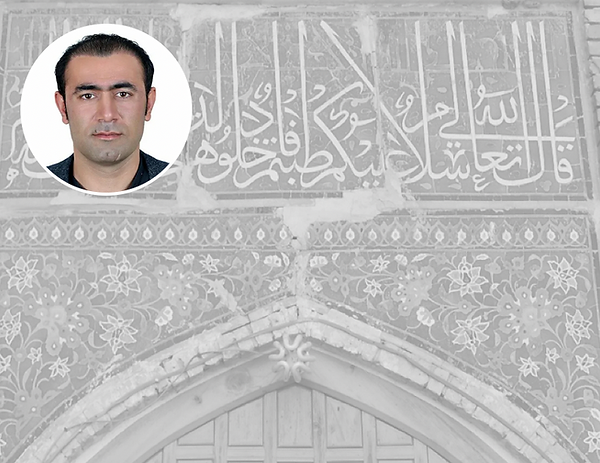Journal of Social and Political
Sciences
ISSN 2615-3718 (Online)
ISSN 2621-5675 (Print)




Published: 18 December 2023
The Characteristics of the use of Eslimi and Rotating Motifs in the Tiling of the Mausoleum of Khwaja Abdullah Ansari Located in Herat Gazargah
Ahmad Shoaib Saljoqi, Mohammad Towfiq Rahmani
Herat University

Download Full-Text Pdf
10.31014/aior.1991.06.04.456
Pages: 202-214
Keywords: Eslimi Motifs, Rotating Motifs, Islamic Art, Tiling, Pattern , Structure, Composition
Abstract
Eslimi and rotating motifs have long been used in the historical monuments of Herat, the tiling industry and the use of Eslimi and rotating motifs in ancient times have always painted the historical and religious monuments of Herat, but its values and characteristics are not introduced for society, artist Students and artisans. The objectives of this research are to evaluate and introduce the latent characteristics Eslimi and Rotating motifs use of in the tiling of the mausoleum of Khajeh Abdullah Ansari in Herat, to develop public awareness of the values of these motifs and apply the results of the present study in the field of art as a lesson for students. This research has been done by library, field, observational and qualitative method. Visual research method is used in this article and the first hand data, which are the patterns on the tiles, have been analayzed and interpreted by the authors of the article in visual research. The results of the research show that: The Eslimi element has been used in most of the motifs of the mausoleum of Khajeh Abdullah Ansari, repetition (symmetry) as an action that ends in boredom is not mentioned in the motifs used in the mausoleum of Khajeh Ansari, Eslimi movement (Snail) is a symbolic movement of ascension that leads man to perfection, diversity, variety, types of structures, different compositions and multiplicity of elements are the prominent features of the motifs of the mausoleum of Khajeh Abdullah Ansari, the existence of simplicity in some of the motifs of the mausoleum mansion of Khajeh Abdullah Ansari shows the strong understanding of the artist of the pattern of aesthetics, the combination of objectivity and mentality in the engravings of the mansion of Khajeh Abdullah Ansari is clearly evident.
References
Abolufai Bozjani, Muhammad bin Muhammad (2010). Iranian Geometry, Seyyed Alireza Ezhevi, Tehran: Soroush, 4th edition.
Iskanderpour Khorrami, Parviz (2001). Khataei Flowers, Tehran: Ministry of Culture and Islamic Guidance Printing and Publishing Organization, third edition.
Eskanderpour Khorrami, Parviz (2004). Eslimi and Nishan-ha, Tehran: Printing and Publishing Organization of the Ministry of Culture and Islamic Guidance.
Al-Bhansi, Afif (2012).Islamic Art, Mahmoud Pouraghasi, Tehran: Surah Mehr, third edition.
Eva Wilson (1989). Islamic designs, Tehran, Mohammad Reza Rithi, 5th edition, Samt Publications.
Brand, Barbara (2004). Islamic art, Dr. Mahnaz Shayeshita Far, Tehran: Islamic Studies Institute.
Burkhart, Titus (1990). Honer maghods, Jalal Sattari, Tehran: Soroush.
Burkhart, Titus (2012). Islamic Art, Masoud Rajab Niya, Tehran: Soroush, second edition.
Seljuqi, Fekri (1962). Gazergah, Herat: AKTCHRT-Library-231.
Seljuqi, Fekri (1976). Ariana, historical, literary and philosophical quarterly magazine, Kabul: Ministry of Information and Culture.
Solmaz, Amir Rashed (2009). The forgotten treasures of Iranian art, symbols of ancient Iran in today's art, Tehran: Text
Kohnmuyipour, Jhaleh (2007). Essays on the thoughts of Barthes and Derrida, Roland Barthes and visual signs, by the effort of Amir Ali Najoomian, Tehran: Farhangistan Honar.
Khalili, Nasser and David James (2001). Elaborate works (Taghran 8 A.H. Qur'an writing), Payam Behtash, Tehran, Noor Vakar Rang Foundation, vol. 2.
Rostami, Majid Reza (2016). Decorative patterns ,Tehran, Fakhrkia.
Sadegh, Sofia Tazi (2009). Synthesis of artistic imagination, words and imaginary world in Islam, Tehran: Text.
Swabi, Abdul Naser (2009). Analyzing Timurid period gravestone motifs in Herat Gasargah, Herat: unpublished master's thesis.
Farhad, Alam (2018). Patterns and decorations in the historical monuments of Afghanistan, Kabul: Motabah Sehr.
Fazli, Seyyed Naidal Haq (2009). Investigating the characteristics of design and color in the tiling of Khwaja Abdullah Ansari's tomb, Herat: unpublished master's thesis.
Lucy Smith, Edward (2002). The last artistic movements of the 20th century, Dr. Alireza Sami Azar, Tehran: Nazar.
Lawler, Robert (1989). Sacred geometry, translated by Haydeh Meiri, Tehran, cultural studies and research.
Maddpour, Mohammad (2005). Hikmat Ansi, Tehran: Surah Mehr.
Makinejad, Mehdi (2009). Forgotten treasures of Iran (hand woven), Tehran: Text.
Naseri, Malih (1981). Eslimi School, Tehran: Art Academy.
Hanrour, Mohammad Reza (2005). Taheeb (Eslimi), Tehran: Mirdashti.
Hanrour, Mohammad Reza (2009). Step-by-step training in the art of gilding and carpet design, Tehran: Yesavali, 4th edition.
